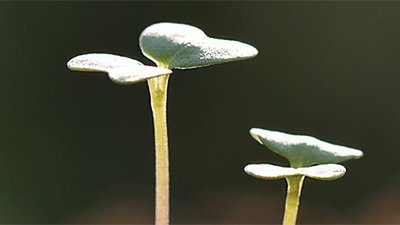
ScienceDaily: “Study of Flower Color Shows Evolution in Action”
ScienceDaily: “Study of Flower Color Shows Evolution in Action” Changes in the color of columbine flowers: another example of “evolution in action” that has little to do with Darwin.
Ecologist Scott Hodges and graduate student Nathan Derieg of the University of California–Santa Barbara conducted the investigation into the genes that control the color of columbine flowers.
Natural selection can hypothetically work to change flower color in a population.
Red columbines are commonly pollinated by hummingbirds, while white and yellow columbines are mostly pollinated by hawkmoths. (The scientists have experimentally confirmed that hawkmoths prefer the paler colors.)
Because of this relationship, natural selection can hypothetically work to change flower color in a population. For example, if hawkmoths were to replace hummingbirds as pollinators of a population of red columbines, natural selection would favor the paler columbines, and the population would gradually shift toward more white and yellow flowers. The opposite should be true as well: hummingbird pollination would encourage a pale-colored population to shift toward more red flowers. (In both cases, note that individual flowers would not change color; rather, individuals of the population that are of a certain color would be more successful at reproducing than those of another color, causing the entire population to change over time.)
“Having identified all the genes that are intimately involved with making red and blue columbines now allows us to determine how these evolutionary transitions have occurred,” Hodges explained. He and Derieg worked to determine whether such color shifts have actually happened. The team concluded that a shift from red to white or yellow has happened five times in North America.
The changing colors of flower populations in response to new pollinators is a terrific example of natural selection in action. But it isn’t an example of the sort of evolution that supposedly turned molecules to men over millions of years. That “evolution” would have required dramatic increases in genetic information, akin to a columbine flower developing a sophisticated, entirely new anatomical feature through chance mutations—something we don’t observe. This study reminds us that the term “evolution” is frequently used to mean these two very different ideas. Through equivocation, scientists attempt to “prove” the second meaning with the first.
For more information:
Remember, if you see a news story that might merit some attention, let us know about it! (Note: if the story originates from the Associated Press, Fox News, MSNBC, the New York Times, or another major national media outlet, we will most likely have already heard about it.) And thanks to all of our readers who have submitted great news tips to us.
(Please note that links will take you directly to the source. Answers in Genesis is not responsible for content on the websites to which we refer. For more information, please see our Privacy Policy.)
Recommended Resources

Answers in Genesis is an apologetics ministry, dedicated to helping Christians defend their faith and proclaim the good news of Jesus Christ.
- Customer Service 800.778.3390
- © 2024 Answers in Genesis






